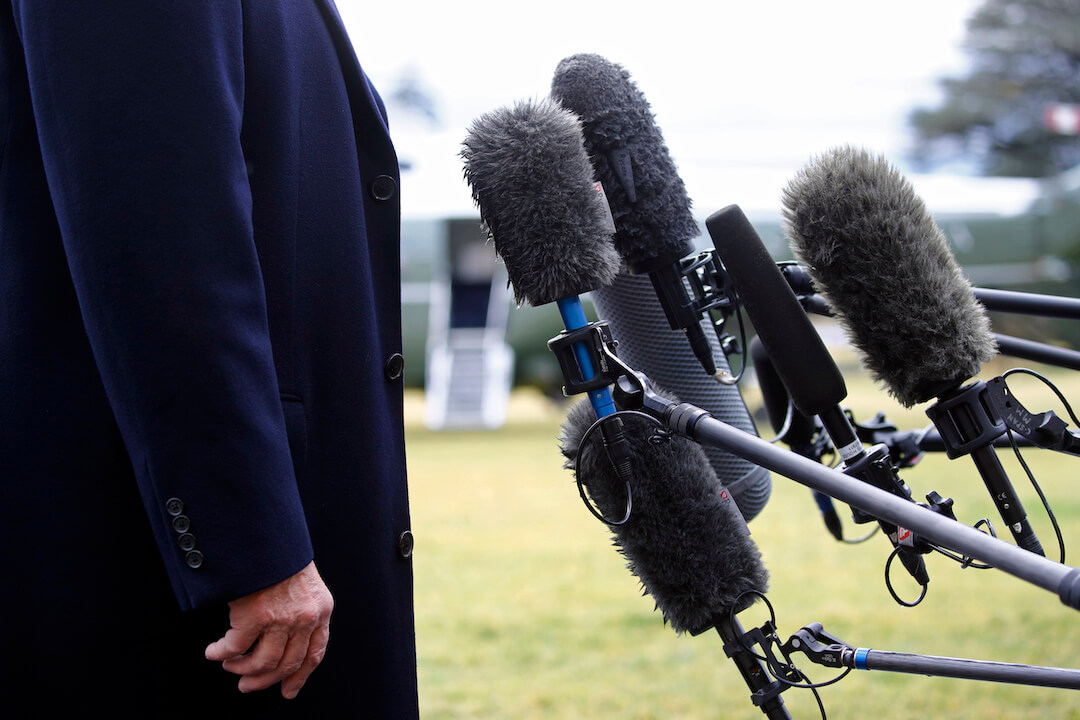A Gallup poll released this week found that Americans’ trust in mass media to report “fully, accurately and fairly” is only two points higher than the lowest Gallup has ever recorded.
The results, which are essentially unchanged from last year, show that only 7% of Americans have “a great deal” of trust and confidence in the media, while 27% say they have “a fair amount” of trust in mass media.
Twenty-eight percent of U.S. adults surveyed in the poll say they don’t have much confidence in the media, with 38% saying they have none at all.
The results are only two points higher than Gallup’s all-time low for media trust in 2016, during the lead-up to that year’s presidential election.
Other takeaways from the poll include:
- This poll is the first time the percentage of Americans with no trust in the media at all is higher than the percentage of respondents with a great deal or fair amount of trust combined.
- The partisan divide remains strong with media trust, with 70% of Democrats saying they have a great deal or fair amount of confidence in the media, while 14% of Republicans and 27% of independents say the same.
- A majority of Republicans indicated they have no trust at all in the media for the third straight year.
By Annie Aguiar, audience engagement producer
When The New York Times was in deep financial trouble
For the last several years, The New York Times has been a model of growth, financial strength and digital acumen while the rest of the legacy news industry contracts and struggles. It was not always thus.
As Timesman Adam Nagourney recalls in his new book on the newspaper, the Times had, to put it mildly, a bumpy transition to a digital news and business model. The late aughts and first years of the 2010s were characterized by false starts and a steady stream of objections from print purists.
Nagourney’s account brings back memories of initiatives that ended in the dustbin. Those include About.com, an information potpourri organized around more than 500 topics. It didn’t generate the hoped-for growth and profits. Bought in 2005, About.com was sold in 2012, but it was a failure that can be seen now as a forerunner to the Times’s successful Wirecutter product recommendation site and other verticals like Cooking and Games. Its fleeting role in the Times’ digital strategy barely rates a mention in the book.
A much bigger deal was TimesSelect, the paper’s first pass at a digital paywall. For $49.95, subscribers got access to a bundle of the Times’ most popular columnists and the paper’s archives. (The rest of the site remained free).
As Nagourney writes, TimesSelect, though an ill-conceived approach, was addressing a real problem — disappointing digital ad growth and the need for digital subscription revenue. The offering was not a business dud, growing to $10 million in annual income. But it was wildly unpopular with columnists like Thomas Friedman and Maureen Dowd, who saw their readership plummet, especially abroad, where a print New York Times was not available. Started in 2005, TimesSelect was scuttled just two years later.
TimesSelect, like About.com, turned out to be one of those proverbial flops that yield valuable lessons. By 2011, The Times launched a broader metered paywall that allowed some free reading and a boost to traffic but, more importantly, served as a teaser for paid digital subscriptions. It was a shrewder-than-shrewd move in retrospect, blazing a path to The Times’ current paid digital circulation of 9 million, but the plan was hotly debated by news and business executives. Those running the site worried that a paywall would torpedo readership and depress advertising.
These false starts along with a deep advertising recession had the Times on the financial ropes near the end of the decade. At a low point (also mostly forgotten now), the Times borrowed $250 million at a 14% interest rate from Mexican telecom billionaire Carlos Slim Helú.
A few armchair analysts — Michael Wolff and Atlantic magazine contributor Michael Hirschorn — forecast that the Times as we know it would be out of business within a year. That was alarmist and wrong. The Times still had a lot going for it — committed family ownership by the Sulzbergers, a loyal and growing national and international readership and steady editorial excellence.
I wonder whether the history of that period points the way for legacy franchises to get past their late and halting digital starts and salvage a future for local news. Maybe. Few of the rest have a package of strengths analogous to those of the Times.
I should be clear that while my focus is on the business side, Nagourney’s is not. He writes mainly of owners, editors, reporters and landmark journalism events — with some scandals mixed in among the triumphs. Remember the fabrications of Jayson Blair or Judith Miller’s reporting on Iraq’s alleged weapons of mass destruction?
Released 10 days before Marty Baron’s “Collision of Power,” an account of his tenure as Washington Post executive editor, the Times weighs in at a comparable page count — 471 vs. Baron’s 478. Dueling tomes and well executed with plenty of tasty nuggets for a browsing reader, too.
By Rick Edmonds, media business analyst
Pittsburgh Post-Gazette journalists mark one-year strike anniversary
When Pittsburgh Post-Gazette photojournalist Steve Mellon walked off the job last October, he thought the strike would be over by Thanksgiving.
One year later, roughly 35 unionized journalists — along with 55 other advertising, production and distribution staff — are still on strike. Little progress has been made at the bargaining table since then, and workers say the Post-Gazette and its owner Block Communications are slow-walking negotiations.
“A year is nothing to celebrate,” Mellon said. “I certainly commemorate it, but I’m not going to high-five that we’ve been on strike for a year. That does not feel like a success to me. We’re all frustrated.”
The journalists, represented by the Newspaper Guild of Pittsburgh, have the same three demands that they did last October. They want the Post-Gazette to restore the guild’s old contract that expired in 2017 and to begin negotiations for a new one. They also want the company to reinstate health care coverage to their advertising, production and distribution colleagues, who began striking after they lost coverage.
With both sides refusing to budge, the journalists are hoping that they can get some relief from the federal court system. They await a ruling from the National Labor Relations Board that they say could end the strike.
In the meantime, they continue to walk picket lines, fundraise for their colleagues and contribute to the union’s strike newspaper, the Pittsburgh Union Progress.
Education reporter Andrew Goldstein, whose coverage of the 2018 Tree of Life synagogue shooting helped the Post-Gazette win a Pulitzer Prize, said he looks forward to going back to the paper. He grew up in Pittsburgh, and he joined the Post-Gazette straight out of college.
“In a way, it feels like my home,” Goldstein said. “I feel like right now my home has been stolen from me, and I want to go back. I want it returned to me, and I want things to be made right.”
Read more about the strike on Poynter’s website in “One year on strike: Pittsburgh Post-Gazette journalists are frustrated but remain resolute.”
By Angela Fu, media business reporter
US-Russian journalist detained in Russia

In this handout frame released by Radio Free Europe/Radio Liberty, Radio Free Europe-Radio Liberty editor Alsu Kurmasheva pose for a photo during a work break at Radio Free Europe/Radio Liberty headquarters in Prague, Czech Republic, Wednesday, March 6, 2013. (Claire Bigg/Radio Free Europe/Radio Liberty via AP)
Alsu Kurmasheva, an editor with American-funded broadcaster Radio Free Europe/Radio Liberty, has been detained by Russian authorities for failing to register as a “foreign agent.”
According to RFE/RL, Kurmasheva, a dual citizen of the U.S. and Russia, traveled to Russia for a family emergency in May and was temporarily detained on her return flight. Authorities confiscated both of her passports, fining her for failure to register the U.S. passport with Russian authorities.
The new charge for failure to register as a foreign agent was announced on Oct. 18. It carries a maximum sentence of five years in prison.
“Alsu is a highly respected colleague, devoted wife, and dedicated mother to two children,” said RFE/RL acting president Dr. Jeffrey Gedmin in a post announcing the detainment. “She needs to be released so she can return to her family immediately.”
By Annie Aguiar, audience engagement producer
Media tidbits and links for your weekend review
- The Washington Post’s Drew Harwell with “Elon Musk’s X removes the New York Times’ verification badge.” Harwell writes, “The badge was the only symbol distinguishing the Times’ 55-million-follower account from impostors amid two major global conflicts in Israel and Ukraine. X has hosted and helped amplify a flood of false information related to the Israel-Gaza war, some of which Musk has personally endorsed.”
- Google has cut 40 to 45 jobs in its news division, reports CNBC’s Jennifer Elias. Google News curates news articles from across the internet and presents them in a ranked order in an easy-to-find tab on the world’s most popular search engine. The downsizing comes as a war between Israel and Hamas gets underway and another between Ukraine and Russia moves into its 20th month. “Both wars,” Elias reports, “have spawned a surge in the spread of misinformation across the web, heightening the importance of Google and other sites that users count on to find up-to-date news.”
- The Hill’s Dominick Mastrangelo with “NewsNation, The Hill hire media critic Steve Krakauer.” Krakauer is the executive producer of SiriusXM’s “The Megyn Kelly Show.” Mastrangelo wrote, “Krakauer’s commentary and analysis have been featured predominantly in conservative media spaces in recent years, with the pundit making appearances on Fox News, popular right of center podcasts and other outlets catering to conservatives during his career.”
- Variety’s Brian Steinberg with “Bret Baier Hunts for Big Newsmakers to Bolster Fox News’ ‘Special Report.’”
- The Associated Press’ David Bauder with “Journalists in Gaza wrestle with issues of survival in addition to getting stories out.”
- Nieman Lab’s Sarah Scire with “Wait, wait, don’t tell me how this Canadian radio show became a TikTok hit.”
- For Slate, Scott Nover with “Elon Musk doesn’t really want your dollar. He wants you to pay to post so he can have something more valuable.”
- Deadspin’s Julie DiCaro with “Is ESPN ethically obligated to shut down wild speculation on the Pat McAfee show?”
- For The New York Times Magazine, Robert Kolker with “The Botched Hunt for the Gilgo Beach Killer.”
More resources for journalists
- Subscribe to Poynter’s Friday newsletter, Open Tabs with Poynter managing editor Ren LaForme, and get behind-the-scenes stories only available to subscribers.
- Poynter ACES Introductory Certificate in Editing (Online) — Enroll now.
- How to Improve Your Coverage of LGBTQ+ Communities (Webinar) — Start anytime.
- Got a story you’d like to write for Poynter? Email pitch@poynter.org with your idea, approximate timeline and word count.
Have feedback or a tip? Email Poynter senior media writer Tom Jones at tjones@poynter.org.
The Poynter Report is our daily media newsletter. To have it delivered to your inbox Monday-Friday, sign up here.








